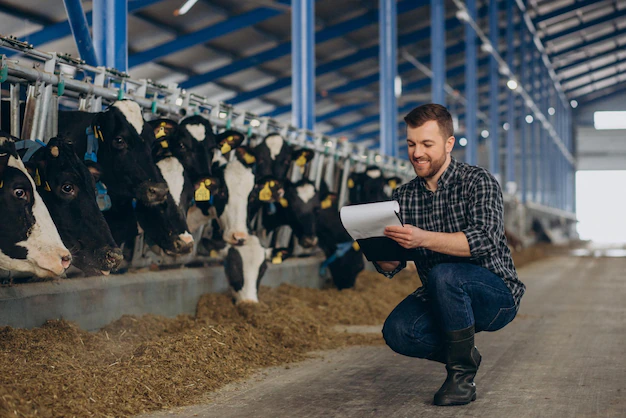Livestock farming is a mix of time-honored traditions, on-the-job learning, and constant adaptation. Many essential practices aren’t written down in manuals but passed down through generations. Here’s a deeper dive into 20 unwritten rules that make a difference in livestock farming, complete with examples to help you better understand these practices.
1. Respect the Herd Hierarchy
Animals naturally establish a hierarchy, which helps reduce conflicts. For example, when introducing a new cow into a herd, it’s important to watch from a distance and let the animals sort out their order. Trying to interfere may increase stress and aggression. Often, animals will work out their hierarchy within a few days if left undisturbed.
2. Early Mornings Are Sacred
Livestock farming starts at dawn because animals are typically active and expect routines. Morning checks are crucial for assessing animal health and feeding, and early hours are often calmer and cooler, making them ideal for labor-intensive tasks. For example, many dairy farmers begin milking at 4 or 5 a.m. to keep the routine consistent, which helps maintain milk production.
3. Routine Is Everything
Animals are creatures of habit, and keeping a consistent schedule reduces stress and increases productivity. For example, feeding your pigs at the same time each day can prevent aggressive behavior as they know when to expect food. Sudden changes, like a delayed feeding, may lead to agitation and could even cause animals to stop eating.
4. Listen to the Animals
Animals communicate in subtle ways. For instance, sheep that keep their heads low or avoid others may be showing signs of illness, while a normally vocal goat that’s unusually quiet could be feeling unwell. Noticing these subtle signs can allow for quick interventions before issues worsen.
5. A Watchful Eye Is Your Best Tool
Observing each animal daily allows you to spot changes early. A sudden limp, a swollen udder, or a refusal to eat can all signal problems. For example, cattle with bloat often exhibit signs like swollen left sides or labored breathing, which require immediate attention. A quick inspection routine can help catch such issues early.
6. Don’t Overcrowd
Animals need adequate space to avoid stress and injury. For example, if a chicken coop is overcrowded, chickens may start pecking each other, leading to injury and increased susceptibility to disease. Providing ample space also helps prevent the spread of illness, as animals aren’t forced to be in constant close contact.
7. Quality Feed, Not Just Quantity
Feeding isn’t just about filling troughs; the nutritional quality of feed matters. For instance, giving dairy cows feed high in protein and energy improves milk production. Skimping on feed quality to save costs can lead to malnutrition, reduced production, and higher vet bills in the long run.
8. Water Is Non-Negotiable
Fresh, clean water should always be available, as even a short period of dehydration can impact health. During summer, animals may need two to three times more water. For example, a dairy cow may require 30-50 gallons of water a day. Having automatic waterers with a constant flow can be helpful but should be checked regularly to ensure functionality.
9. Invest in Good Fencing
Strong fencing prevents livestock from escaping and keeps predators out. For example, sheep are prone to panic and can easily slip through gaps in poorly maintained fencing. A sturdy fence can prevent such escapes, saving time and resources that might otherwise be spent on animal retrieval.
10. Be Ready for All Weather
Livestock farming requires adapting to weather challenges. During winter, livestock may need extra feed to maintain body heat and windbreaks for protection. Cattle, for example, can withstand cold but need shelter from freezing winds and mud-free areas to rest. Planning for seasonal needs reduces the risk of illness and stress in animals.
11. Learn Basic Veterinary Skills
Knowing basic veterinary care is essential in livestock farming. Learning to administer vaccinations, clean wounds, and recognize symptoms of common diseases can save time and money. For example, a lamb with a minor cut can be treated with antiseptics and bandages, but knowing when to call a vet for a serious infection is also crucial.
12. Know Your Animals’ Growth and Lifecycle
Each species has specific needs at different life stages. For example, pregnant sows require extra nutrients, and calves need a different diet as they wean off milk. Understanding these stages helps ensure the animals grow well and stay healthy, which directly affects productivity.
13. Minimize Stress
Stress can impact animal health and productivity, so calm handling is essential. When moving animals, such as guiding cattle through a chute, it’s better to move slowly and use low-stress handling techniques. Avoid loud noises and sudden movements, which can lead to injuries and make animals skittish.
14. Prepare for Breeding and Birthing Seasons
Breeding and birthing seasons require preparation, from stocking up on supplies to ensuring a clean, comfortable environment for mothers and newborns. For example, lambing season can be intensive, as sheep often give birth in groups. Having extra pens, heat lamps, and clean bedding can make the process smoother and reduce risks to newborns.
15. Always Have a Backup Plan for Feed Supply
Feed supply chains can be unpredictable due to weather or market shifts. Having backup sources or stored feed, like hay, ensures that your animals won’t go hungry. For instance, many farmers prepare silage or hay bales during the summer to ensure they have enough to last through winter.
16. Rotate Pastures When Possible
Rotational grazing improves soil health and prevents overgrazing. For example, moving cattle to a new pasture every few weeks allows grass to regrow, providing animals with fresh forage and reducing parasite load. This strategy promotes sustainability and pasture quality.
17. Your Reputation Matters
A farmer’s reputation can open doors or close them. Being honest and dependable in your dealings with local suppliers, vets, and other farmers builds trust and community. If you’re known for caring well for your animals, local buyers are more likely to trust the quality of your livestock.
18. Don’t Take Shortcuts on Cleanliness
Cleanliness is crucial for preventing disease. A clean barn reduces flies and bacteria that can cause illness. For example, regularly replacing straw bedding in pig pens helps prevent respiratory issues. Manure should be removed often to keep pens dry, minimizing infection risks.
19. Patience Is Key
Animals won’t always cooperate, and farming is unpredictable. If you’re herding sheep and they’re scattering, take a deep breath and try again with a calm approach. Developing patience allows you to work effectively, even when things don’t go as planned.
20. Take Pride in Your Work
Livestock farming is tough, but celebrating small victories can keep you motivated. Seeing healthy newborns, a clean barn, or strong animals reminds you why you chose this path. Taking pride in your farm’s successes—even in small, everyday accomplishments—builds a positive, sustainable outlook.
These unwritten rules, passed down through generations of farmers, build a solid foundation for running a healthy, productive, and rewarding farm. Following these principles helps keep animals healthy, facilities efficient, and the farmer resilient through the unique challenges and joys of livestock farming.







